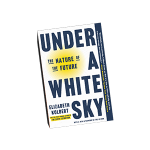Week 2: Craft and Calamity
Hello Deep Readers,
Welcome to Week 2! Catch up on Week 1 if you haven’t yet.
This week, we’re aiming to better understand the craft of Under a White Sky with the help of Jody Biehl, UCSC Professor of Humanities and Journalism. We’ll be thinking about Elizabeth Kolbert’s New Journalism techniques and approach as she depicts sites of impending calamity and creative responses to them.
Let’s dig in.

Kolbert’s New Journalism
As we work our way through Under a White Sky, it’s important to think about Kolbert’s journalistic approach to her subject. We connected with Jody Biehl to help us better understand Kolbert’s craft. Biehl is an award-winning journalist who has worked at The New York Daily News, The Santa Rosa Press Democrat, The San Francisco Chronicle, and Der Spiegel.

“Kolbert has a style where she throws herself into her topics in the tradition of the Gonzo journalists of the 1960s,” said Biehl. “She goes on the boats, and gets splattered with fish. She gets in the water and goes diving. She’s great at finding ways to tell a complicated story. She finds really interesting characters that help narrate something that, for the public, is a hard topic to get our heads around.”Like these earlier journalists, Kolbert is not separate from the scene she narrates, but a part of it. She is at once a participant and an observer. One early example of Kolbert’s New Journalistic approach is her depiction of her trip down the Chicago Sanitary and Ship Canal. She offers us “fly-on-the-wall” details, describing the color of the water (“the shade of old cardboard”), the candy wrappers and bits of Styrofoam bobbing in the water and the billboard-sized and increasingly dire “warning” signs she and the crew pass. She makes us feel like we are on the boat, sharing in the animated speculation about what sort of “floatables” the group might encounter amid the sewage overflow. And she tells us, “there’s joking on board that one of us should dive into the river electric, or at least stick a hand in to see what happens.”
“She is both our guide and part of the action,” Biehl said. “She helps us see the irony of an electrified river that we’ve reverse engineered to flow the opposite way nature intended. It’s a feat of tremendous human ingenuity, but also a folly that creates unintended consequences.”
Biehl connects Kolbert to the legacy of New Journalism popularized in the 1960s and 70s by writers such as Joan Didion, Tom Wolfe, and Hunter S. Thompson: “She’s got an eye for finding what we call the journalistic hook of a story and picking out details and specific people to tell it. She uses stories to help us grasp a tough topic,” Biehl says. “She doesn’t overtly tell us, ‘you need to take time out and worry about this.’ She shows us why we need to worry. She leads us there. It’s a useful way to make such a tough topic understandable for lay people.”

New Journalism represents a shift in how journalistic stories are told, namely placing the subjectivity of the writer at the center of the story and moving away from the convention of journalistic “neutrality” and “objectivity.” It is a genre defined and emphatically promoted by Tom Wolfe (left, at the UCSC Quarry Amphitheater in 1987) in his 1973 anthology titled, fittingly, The New Journalism. Wolfe—who wrote feature articles for the New York Herald Tribune and its Sunday supplement, New York—charts the development of New Journalism from the perspective of the Manhattan newspaper and literary scenes.
Wolfe sees Gay Telese’s Esquire article, “Joe Louis: The King as Middle-Aged Man” (1965), as the beginning of a change in the form of feature writing. This profile of the famous boxer melded journalism with short story structures, inciting suspicions at the time about the article’s journalistic integrity because “really stylish reporting was something no one knew how to deal with, since no one was used to thinking of reporting as having an aesthetic dimension.” With Kolbert, we have a similar New York home base—in her case, The New Yorker—and literary techniques melded with journalistic chops. Her subjective and participatory approach is an effective and engaging way to make the stakes of climate change mitigation and scientific research feel human, visceral, and relatable. As Biehl noted, “She guides us. She holds our hand and takes us on the boat, down the electrified river, and has us looking at the fish guts that are all over her feet and on her recording device.”

Go Deep
What are some techniques that Kolbert is using to tell her story that stand out to you? Do you find them effective, interesting, or engaging? Is her approach limited, or perhaps manipulative or leading, in any way? Does this take away from the overall validity of her story and approach? Should journalistic work strive to be objective, as is the case with traditional journalism, or does it make sense for the writer to be an obvious part of the story?
Join the community conversation: We encourage you to think through these questions as you read and share your thoughts in the comments below 👇
Community Conversation
Share your thoughts, reactions, and ideas with the Deep Read Community. Please note, comments are moderated and won’t populate immediately. Send any questions to deepread@ucsc.edu.
